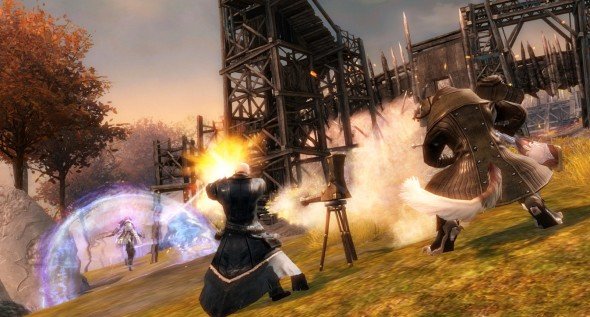
As soon as we found out that we'd be playing in Guild Wars 2's beta for an entire weekend, we asked you, our beloved readers, what you wanted to us to find out for you while we were in there. We pulled questions from Facebook , Twitter , and Google+ (and came up with a few of our own as well) and had Gavin and Josh, who both spent all weekend playing the beta up through level 30 in the beta, give you their thoughts on everything from microtransactions to dungeon runs.
We also grabbed hundreds of GBs of gameplay footage, which we'll be putting together into narrated videos showcasing character creation, guild features, graphics settings, combat, and everything you didn't know you didn't know about Guild Wars 2. We'll be releasing the videos regularly over the next two weeks, so check back often.
1. Does the event system succeed at making the world feel very dynamic and live?

Josh: I was really surprised by how few of the events had branching points or consequences in them. From the content I've played at earlier events and ArenaNet's focus on their dynamic events system, I expected the vast majority of events to change the world as I completed them. That wasn't the case in the parts of Shiverpeak Mountains that I played through on my Norn character. A lot of quests have multiple stages (i.e., steal food from nearby tribe for questgiver and then defend them when raiding party attacks), but I only found two that actually had a real effect on the world--one of them being that centaur castle siege in the human starting zone that ArenaNet's been showing off forever.
Gavin: The dynamic events definitely brought more life to the world. Spontaneous invasions to outposts or seeing a caravan in need of an escort made the world more interesting to explore. The lack of branching events was a bit surprising to me too. I found one or two events where centaurs had actually managed to take over a village, but more often than not, these events barely progressed passed their initial invasion. I hope further in the game players don't have to ignore an event just to see how it will change the landscape of a zone.
Josh: It might just be that it was pretty much impossible to fail an event in these starting zones. I'm hoping that high-level zones will have events that you're just as likely to lose as succeed, which would really allow for some interesting branching. Of course, players would have to get rewards for participating, even if they don't succeed the super objective.
2. Even if it doesn't, is the event system still better than a traditional quest system?
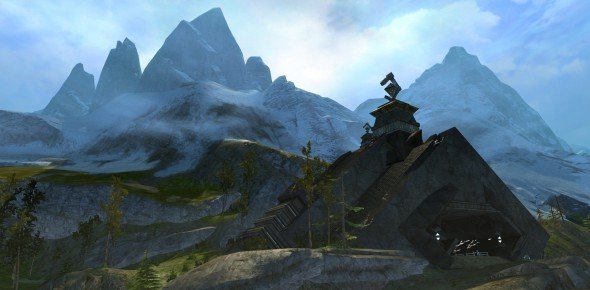
Gavin: Absolutely. I leveled up by trying to explore and discover new things happening around Kryta. The map system does a fantastic job of showing you hints about where you can get things done. My first fifteen levels were spent moving from point to point on the map to figure out what adventure could be found at this marker or rising up to a skill point challenge at another. I also never felt punished for showing up and helping other would-be heroes already there. If I help kill anything, I get credit. Gone are the days of kill-stealing jack holes.
Josh: Yeah, I also really enjoyed the freedom the event system gives. It rewards and encourages exploration really well—anywhere I went, I was pretty likely to run into something that needed doing. Scouts thrown around the world do a good job of giving you a few breadcrumbs to follow (by marking nearby events on your map), and you're bound to run into plenty of other events--like a giant lizard roaming a river basin. Most of the time, I found another player was already working on the objective and I could run in and help out--without the need to group up or anything else.
Keep up to date with the most important stories and the best deals, as picked by the PC Gamer team.
3. Are the activities diverse--or is it still mostly Kill X of Y, run to Z?
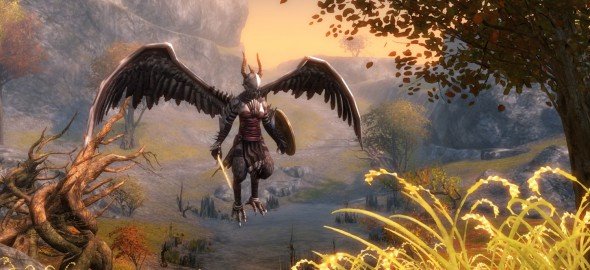
Josh: It's pretty much impossible for RPGs to shake off the idea of having you kill things or interact with objects entirely--just like you're always going to be shooting people in shooters. That said, a few quests in the Norn starting area transformed me into different animal forms with a whole new set of abilities and a few others had some fun objectives, like carrying rabbit food through a massive minefield of rabid rabbits or joining a kids' snowball fight and knocking 'em out.
Gavin: Some of the events are cleverly disguised kill count objectives, but that shouldn't scare you. I never felt like I was just fulfilling a quota for loot. In fact, I didn't even think about a kill-ten-rats reference at all. Each event made me feel as though I was a hero stopping in to do what heroes do: beat stuff up and save the unfortunately weak. Many of the permanent events (always available for players to complete) give you options to how you finish the event. Want to beat things up with a new sword? Do it. Prefer feeding cows or putting out fires in the area? Do that instead. Multiple options in each scenario help keep things refreshing especially when revisiting on an alt.
4. What was your favorite class to play as? Why?
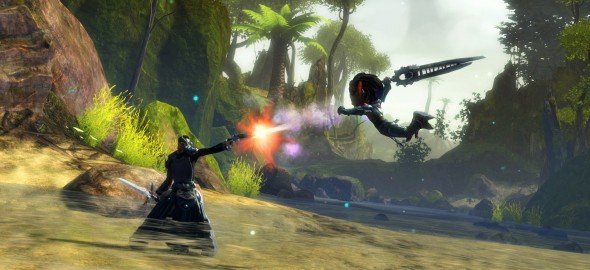
Josh: I mostly played Mesmer this time around because I love the concept of it: tricks, illusions, and pesky as anything in PvP. And it totally lived up to my expectations--half of my abilities created clones that would attack my target and looked EXACTLY like me. My staff was a tool of chaos, giving my entire arsenal random effects (such as random debuffs on enemies and buffs on allies). I could shatter my clones at any time for damage, CC, or a shield that reflected projectiles back at enemies. By the end, I had found an awesome setup that relied on constant blocking and clone-forging that kept me safe from almost all damage, while my army of dopplegangers took 'em down. It's absolutely mindboggling to fight against a Mesmer in PvP--I never knew who to target.
The Thief has awesome movement abilities that teleport him around, but the Engineer was my ultimate favorite with tons of turrets and health packs to toss around. I could lockdown any point in PvP and own it.
Gavin: Surprisingly for me, I loved the warrior class. It was my least favorite class in Guild Wars because I constantly had to chase enemies around while my magic wielding group took turns getting chewed on. This time around I feel more powerful and most of my attacks were serious enough to warrant full attention from any enemy. The weapon skill system really shines while playing warrior. If certain attacks weren't working or got boring, I just swapped to new weapons for an entirely different set of skills. Each weapon gives a distinct experience that gives each class a welcomed diversity. I recommend the two-handed Great Sword which is essentially an AoE centaur blender.
Group pvp was a tad frustrating with the number of knockbacks and roots that rendered me useless, but one-on-one warrior stood toe to toe with almost every class but the Mesmer, whose clones made me feel like an idiot.
5. What was your favorite race? Why?

Gavin: I feel so bland but human was my favorite in this build. The starting experience was one of my favorites and your home is Divinity's Reach, possibly the grandest MMO city I have ever seen. I find it hard to play bigger races, like Charr and Norn, because the movement always feels slower to me. My human warrior was roughly waist height on Josh's Norn Mesmer which made me feel sheepish until I pulled out my two-handed sword. It's a good thing I like being the small guy in a group.
Josh: I was sad: my two favorite races, Asura and Sylvari, were both left out of this build. The Norn's starting area was fun, though. It's focused mainly on animal spirits and taking down big beasts in a harsh, snowy environment. The mountain views are gorgeous and I totally dig the tattooes and bulky look of the Norn. Plus they have Keg Brawl and that's just downright awesome. Humans look pretty sweet, but Charr are just too ugly for my tastes--although their on-all-fours running animation looks super spiffy.
6. How “actiony” is the combat? What game is it most like in terms of combat?
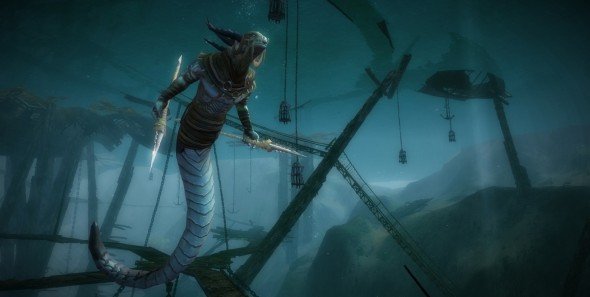
Gavin: It's like someone smashed an action game into old Guild Wars combat. Selecting a target helps focus the direction of a skill, but the target isn't required to use it. For Guild Wars fans, the system feels really similar to the combat you're used to, but with more movement. My favorite mechanic was the introduction of dodging. Double-clicking a direction caused your character to make an evasive jump and roll out of harms way. Many enemies have powerful skills that will knock you down with irritating frequency. Dodging centaur charges or an Ettin's (giant ogre) attacks made the combat feel more lifelike than other MMOs like TOR or WoW. Overall, I never felt like I was stuck in one spot just hitting skills.
Josh: It's tough to describe it entirely in words, so definitely check back for our videos of combat. In short, it's a bit of a hybrid between action RPGs—like TERA or Batman: Arkham City—where it's all skill-shots and no lock-on targeting, and a standard lock-and-spam—like WoW—where you pick your target and if the spell goes off it's guaranteed to hit (barring a bad dice roll). Like Gavin said, you can target enemies and the game will help you face them in combat, but your abilities will always fire, whether you're actually aiming at someone or not. Ultimately, I found it to be pretty "actiony," but I did miss the combo mechanics in a lot of action RPGs that have you clicking in patterns to execute moves. Activating abilities didn't take skill, but making sure they're hitting your target does, and swapping between weapons in combat to unlock your abilities was fairly engaging. On top of that, being able to roll in a direction gives you the tools to avoid hits from enemies, which makes defense exciting (you can do two in a row, and then about 1 every 5-8 seconds after as endurance builds up).
7. What'd you think of Dungeons?
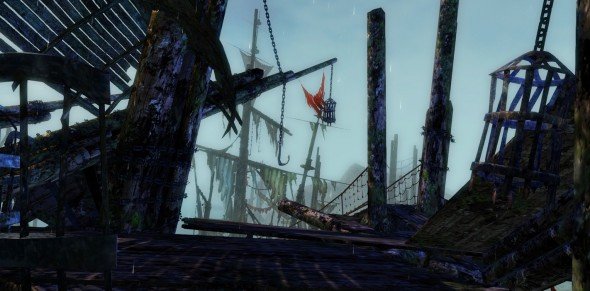
Josh: Man, the one dungeon we ran--Ascalon Catacombs, level 30--was pretty brutal. As a melee rogue with a tendency to use skills that teleport myself off ledges in combat, I died a lot. The fights were nothing groundbreaking, but had interesting mechanics--the trash mobs went quickly and required your full attention if you didn't want anyone to die. The ability to keep fighting when "downed" and ressurrect yourself if you get a kill is awesome--as is the ability for anyone to ressurect anyone else. By the end, I was doing half-naked charges at the final boss because my robe had become broken from me dying too often. Honestly, I think my bulky Norn was way more intimidating that way.
Gavin: If you are used to the organized fighting found in games like TOR and WoW, the dungeons will feel chaotic and incredibly challenging. The fights are a mesh of enemies running around, group members being thrown out of the fray with knockbacks, and blurs of amazing spell effects. Ascalon Catacombs required me to be flexible and adapt on the fly for what my group needed. If someone in my party died, we needed to rally (a form of resurrection) them back into the fight. If damage was high, we'd band together to heal the best we could. It felt fluid but insane all at the same time. The most confusing and challenging aspect was figuring out how to get through rooms full of traps. They killed me more times than I'd like to admit.
8. Does the Holy trinity (helaer, tank, and DPS) exist in the game or not?
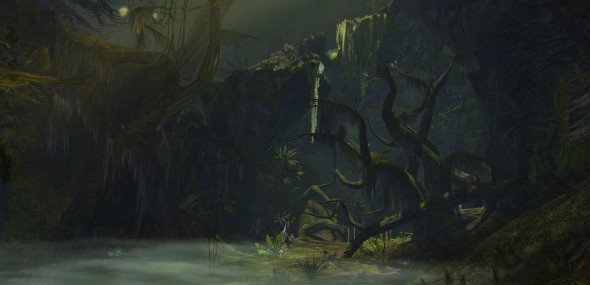
Josh: As someone who didn't play a ton of Guild Wars, it'a still a bit weird to me that there's not a defined capital-T Tank or capital-H Healer, but you definitely do still need someone filling those roles in groups. The difference is that my character is not a healer, but I can act as one in a group. In a lot of MMOs, you have to choose to be a healer, tank, or DPS—and that defines what you're capable of doing everywhere in the world. In GW2, most classes have the toolset to be DPS and either a healer or tank, and can just swap out the weapons, attunements and utility skills to perform that role when needed. My Engineer could bring out health packs and healing turrets and shields if my group needed someone to heal them, or swap them out for rocket launchers and landmines if we wanted damage. The roles still exist, but you aren't as rigidly forced to pick one and stay with it forever.
Gavin: I played Guild Wars and things still feel a little weird, but in a good way. In the first game, tanks were essentially the person who initiated a pull or, at the very least, was the first person to encounter the mobs before they reached the group. In Guild Wars 2, I found that my warrior and guardian characters seemed to pick up aggro much easier than the other classes I played, yet it never guaranteed that the enemy would stick to me or that I'd survive long enough to be effective. The only time I felt as though I was truly tanking was when I took the first barrage of hits when pulling a new group. If nothing else, my role as 'tank' felt more like being a utility class. I set up my skills to provide extra healing benefits or damage control and the heavy armor and traits allowed me to soak up more damage than casters. I felt as though everyone weaved in and out of every role at some point during the dungeon, which was often a welcomed change of pace.
9. How are the instanced PvP Battlegrounds?
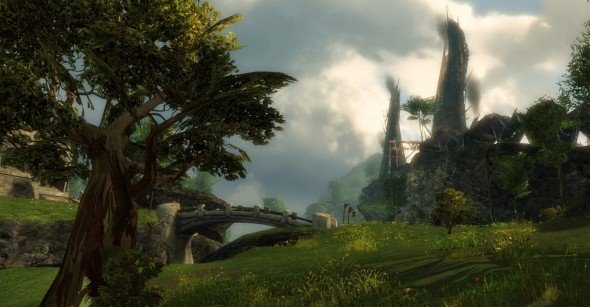
Gavin: What I love about PvP in Guild Wars is something other people may hate: no gimmicky games. Every match feels like it has a place in war. Yes, there are a lot of capture point based scenarios, but isn't that half of what war is? I didn't see any flags in need of capturing or greasy hutballs anywhere. I enjoyed that siege weapons could play a role in a match and how using terrain to your advantage could make or break your defensive or offensive goals. The way skills function (look for our video later this week) mixed really well with their bolstering mechanic, which puts everyone at the same level gear/stats upon joining. If PvP is your thing, this game will give you a meaningful experience faster than anything else on the market.
Josh: I had a good time in the maps I played. Both were capture-point setups in elaborate environments that were pretty fun to run around in. There was a lot of room for nuance and strategy that my PuG group was definitely not taking advantage of. Some had the equivalent of League of Legends' Baron--large NPC bosses that will grant a buff to any team that kills them, and the addition of siege weaponry gives you a lot of ways to contribute. Class balance isn't perfect--but I love that you can create a character from scratch of any class and be playing at max-level PvP with it in under 5 minutes. Entering the PvP area of the game, via an icon in the menu temporarily gives you the full stats and gear of a level 80 PvP god--so everyone's on the same level in a fight. Also, having a games browser that lets you hop in and out of matches like an online shooter is amazing--why hasn't everyone done this by now?
10. How epic is the World vs. World vs. World PvP?
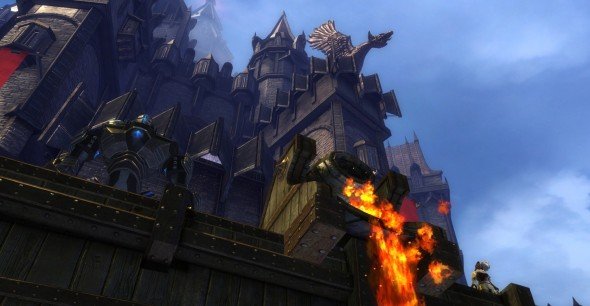
Josh: This could've been the only content in all of Guild Wars 2 and I would probably still have bought it. It's almost impossible to convey the scope of this semi-open-world zone that 3 sides of massive numbers of players battle over. It's like having 20 old-school Alterac Valleys all lumped together in a huge intricate valley with caves, towers, castles, and rivers—without all the crappy side quests and wth a lot more siege weaponry. There are three teams on the map, which pit the entire populations of three different servers against each other, and anyone can go into it at any time. Gavin's putting together a full video on it for later this week, but I had an absolutely blast forming impromptu warbands with my Red-Team brethren. We assaulted caves overrun by enemy players to steal their resources and used them to build catapults. Then we drove those catapults to their towers and laid siege to the keep doors to break our way in and try to take control of it (before dying horribly as a huge group of enemy players rode across the hills to trap us in the valley). Capturing these towers and keeps gives boons to everyone on my server (aka Red Team), no matter where they are playing at the time. This is the sort of thing that guilds will organize watch shifts and specialized raiding parties for.
I only have two complaints about it so far. First, my team was getting slaughtered, without any real way to recover—for six hours, we were being pinned inside our starting fortress. It was still fun, but that's going to get old if one server is always losing. ArenaNet seems optimistic that the three-sided war will help prevent that once more players are in the game, and I hope they're right. Second, I was barely getting any XP at all. I could see myself spending at least half of my total time in GW2 in this mode--I want to get XP for it so I feel like I'm getting some character rewards as well as personal.
Gavin: I said earlier that PvP instances feel like real war scenarios in GW2, but WvW makes them look like child's play. I can't stress it enough, this is huge! The four maps contain the largest PvP land masses of any MMO I've played to date. I ignorantly thought I had time to explore them entirely in a couple hours and probably only saw a fifth of everything before the servers shut down. The various forms of terrain are peppered with objectives to capture and defend. Three servers duke it out for every objective trying to earn bonuses for their entire server. At one point I was helping assault a blue keep when out of nowhere an army of green players showed up and flanked us, causing an absolute slaughter. It was amazing. The next advance, we were destroyed by trebuchets and catapults raining explosives down on us.
The resource systems adds essential depth to the overall warfare. Capturing and securing supply points allows players to begin crafting defensive or offensive structures. I saw player created trebechets, mortars, and even a war golem that ran around pounding players and NPCs into a pulp. The ability to create machines of war not only adds immersion to larger battles, but forces a new way of thinking when forming strategies on which objectives need to be assaulted, defended, or let go to enhance your servers standing.
My one complaint is the difficulty trying to form mobs of players into organized groups. I'd love to see a public group feature, much like in Rift, that allowed players to join forces at the click of a button. Even without the grouping, WvW still has the most potential of any PvP system I have played.
11. What do you think of GW2's PvP in general?
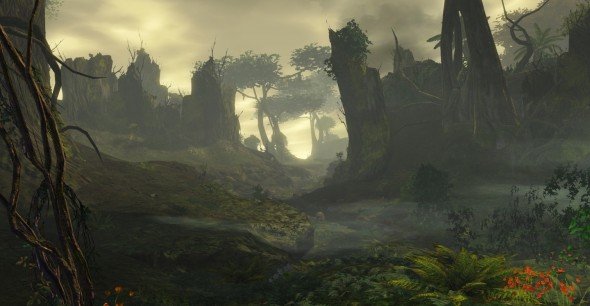
Josh: I absolutely love Guild Wars' dedication to creating balanced PvP environments—partly by making everyone play as a level 80 character in standardized PvP gear, like they did in the original game. But this time you still play with your same character as you do in the rest of the world (in the original you have to make a specific PvP-only character), which goes a long way to keeping up continuity and building loyalty to my character.
Gavin: I agree with Josh. The balance of environments and bolstering of characters to 80 made PvP enjoyable regardless of what level I was. The length of big battles can be a tad exhausting, but the size of WvW combined with the option for instanced PvP scenarios ensures there is always something to do for anyone looking to bring the pain to fellow players.
12. What's the big difference compared to the first Guild Wars?
Josh: Gavin can probably answer this one better than me, but the biggest change for me was understanding how to access all my skills. In Guild Wars, you had to earn them by finding specific trainers hidden around the world, or completing specific quests. In GW2, there are black wings on the map that show you where "skill challenges" are, which are single encounters that seemed to usually require me to beat up someone and reward me with a skill point that I could use to purchase new utility skills from a menu. It was way easier to understand and I never felt like I was crippled because I didn't want to look up on a wiki where to find skills in the world.
Gavin: The skill system is a lot different, but the major change for me was the lack of instanced zones. Guild Wars only allowed players in the same group to share an explorable area, which worked well with the mechanics and quests at the time. In GW2, aside from dungeons and personal quests, every explorable zone is shared with other players roaming around on their own adventures. The cherry on top: players don't have to worry about tagging mobs to get credit, making the swap from instanced content to open world that much easier.
13. How buggy is it, and how soon do you think it'll be out?
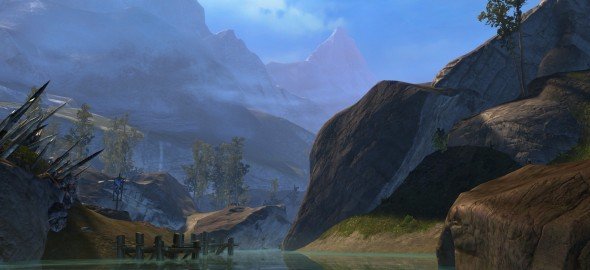
Gavin: Beta's inevitably have bugs but I only ran into a few. I didn't have any issues with crashing or visual glitches, but I did run into three or four events that just failed to spawn creatures or had poorly placed objective markers. Overall, I believe ArenaNet will take a few more months to make sure everything is in working order before release. They have often said the game will come out when the it's ready, and in my opinion, that is looking like mid-summer given their standards.
Josh: The game crashed on me a few times, but only when I was going crazy tweaking the graphics settings for our videos. The Norn area must be more polished than the human zones, because I didn't encounter any bugged quests, and only a few minor visual bugs. That said, we were playing the starter zones, which are usually the most polished and bug-free areas in new MMOs. This looks right on track for where I'd want it to be at the very start of a beta phase. I wouldn't be surprised to see it land sometime in early Summer, but that's total speculation.
14. Are there any cash shop items?
Josh: There was no cash shop or any microtransaction items in the build we played.
Gavin: What Josh said.
15. Can you talk about system requirements at all?
Josh: We'll have a couple videos up later this week that walk you through all the graphics settings currently in the game and how they affect the framerates and visuals. In brief, the game ran pretty smoothly on my machine (7.5 Windows rating, 3.20 GHz six-core CPU, 8 GB RAM, AMD Radeon HD 6900). On maxed-out settings I was getting about 15-30 FPS depending on where I was--high population or huge vistas slowed it down. Moving down the graphics settings, I could run 30-60 FPS no problem.
One big thing to note here is that engine optimization is usually being done until the very last second before release (and continuing afterwards, of course) and that the game will actually run smoother at launch than it does in beta.
Gavin: I loved how Guild Wars managed to make a beautiful game with such low requirements. I'm not sure what the bottom end will be with Guild Wars 2, but the game's visuals scaled well from lowest to highest settings. My home computer (5.9 Windows rating, 2.9 GHz dual-core, 8GB RAM, NVIDIA GeForce GTX 570) ran the game smoothly around 30 fps on maxed-out settings. The only major issues I had with performance were directly related to the amount of players in WvW.
I'd expect this to be surprisingly easy on system requirements upon release, especially given how stunning the world is.
16. How would you compare it to WoW, TOR, and Rift?
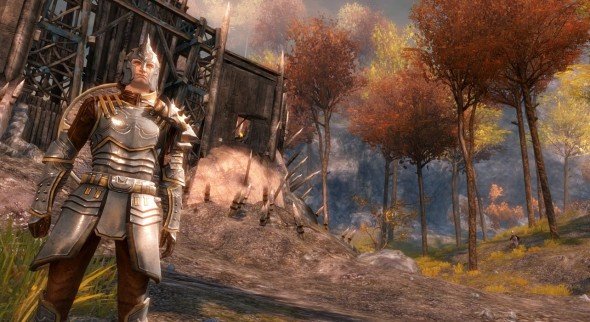
Josh: Well that's a loaded question. I wouldn't want to compare them directly without seeing more of GW2, but I will point out that GW2 does share a lot of strengths with those games. It has instanced story areas like TOR to facilitate good roleplaying in the player's main storyline (although these areas seem to be much, much less frequent around the world than TOR's, which are just about everywhere). It has the dynamic events system like Rift's namesake invasions, and it has a lot of great side pursuits and large-scale open world PvP like WoW did at its launch. The biggest differentiators for GW2 would probably be its combat system (especially underwater combat and weapon-swapping), its events questing system, and the grandoise PvP content that's kept partioned off so that only those interested in it participate.
Gavin: Josh is absolutely right. The game melds a lot of systems we have come to love in other games yet still managed to hold onto the Guild Wars feel. I don't think it's fair to directly compare these systems till launch, but I will say this game is heading in the right direction to appeal to old and new fans alike. The biggest difference can be found in the combat system and dungeons. The lack of defined holy trinity adds a type of chaos that fans of the original Guild Wars will understand and love. Players who preferred the more rigid PvE role structure found in WoW, TOR and Rift will find it tougher to get used to. All in all, this game should be a nice addition for fans of the first game and players just looking for something new in their MMO rotation.
Need more questions answered? Toss 'em in the comments below, or read the big Q&A Josh did on Google+ yesterday for more info!
PC Gamer is the global authority on PC games—starting in 1993 with the magazine, and then in 2010 with this website you're currently reading. We have writers across the US, Canada, UK and Australia, who you can read about here.


